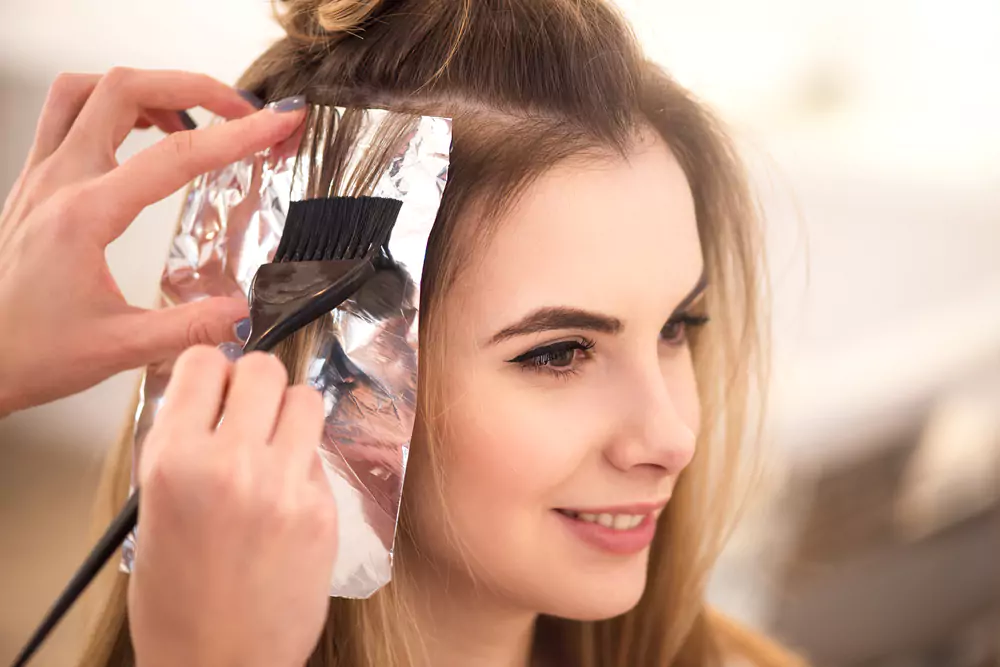Have you ever thought can I apply hair color on oily hair? Many individuals with oily hair often hesitate to experiment with hair color due to concerns about the effectiveness and longevity of the results. In this article, we will delve into the topic and provide a comprehensive guide on whether or not you can apply hair color on oily hair.
We will explore the factors to consider, potential challenges, and effective techniques to achieve desired results. So, let’s dive in and find out if you can confidently transform your oily locks with a vibrant new hue!
Is It Possible To Apply Hair Color On Oily Hair?
Yes, it is possible to apply hair color on oily hair. However, excess oil on the scalp and hair can affect the absorption and effectiveness of the hair color. It is recommended to properly cleanse and prepare the hair before applying the color to ensure better results. Using clarifying shampoos or oil-absorbing products can help remove excess oil and create a clean surface for the hair color to adhere to.
Will The Hair Color Adhere Properly To Oily Hair?


The adherence of hair color to oily hair can be challenging. Oily hair tends to have a buildup of natural oils and product residues, which can create a barrier between the hair shaft and the hair color. This barrier may prevent the color molecules from adequately penetrating the hair cuticle and adhering to the strands.
As a result, the color may appear less vibrant and long-lasting than desired. It is recommended to thoroughly cleanse the hair and scalp before applying hair color to remove excess oil and buildup. Additionally, using a clarifying shampoo or pre-color treatment can help remove any residue further and prepare the hair for optimal color absorption.
Can The Oiliness Of The Hair Affect The Outcome Of The Hair Color?
Yes, the oiliness of the hair can indeed affect the outcome of hair color. When hair is excessively oily, it can create a barrier that hinders the penetration and absorption of hair color products. The natural oils produced by the scalp can prevent the hair dye from fully adhering to the hair shaft, resulting in uneven or patchy color.
Additionally, oily hair tends to have a smoother surface, which makes it more difficult for the color molecules to adhere and stay in place. This can lead to faster fading and a shorter lifespan of the hair color.
Specific Precautions To Take When Applying Hair Color On Oily Hair
Applying hair color on oily hair can be challenging and requires extra precautions to achieve the desired results. Here are some specific precautions to take when applying hair color on oily hair:
Use a clarifying shampoo before coloring
Oily hair can have a buildup of product and dirt, hindering the color from penetrating evenly. Using a clarifying shampoo before coloring will help remove this buildup and ensure that the color adheres better to the hair.
Choose the right color
Select a hair color that is specifically formulated for oily hair. These colors are designed to penetrate deeper into the hair shaft and provide longer-lasting results.
Use a semi-permanent or demi-permanent color
Permanent hair colors can be too harsh for oily hair and may cause damage. Instead, opt for a semi-permanent or demi-permanent color that will provide a subtle change in color without damaging the hair.
Apply a pre-color treatment
Applying a pre-color treatment can help open up the hair’s cuticle, allowing the color to penetrate more evenly. This treatment can also help to reduce the appearance of oiliness during the color process.
Use a color-depositing conditioner
After coloring, use a color-depositing conditioner to help lock in the color and moisturize the hair. This will help to maintain the health and integrity of the hair while providing long-lasting results.
How Does The Oiliness Of The Hair Impact The Absorption Of The Hair Color?
The oiliness of the hair can significantly impact the absorption of hair color. When the hair is excessively oily, it creates a barrier on the surface of the hair shaft, making it difficult for the color molecules to penetrate and adhere to the hair cuticle. The natural oils the scalp produces can act as a protective layer, preventing the color from fully saturating the hair strands.
As a result, the color may appear uneven or fade more quickly. Additionally, oily hair tends to have a smoother texture, which can make it harder for the color molecules to grip onto the hair shaft.
On the other hand, if the hair is too dry and lacks natural oils, it may absorb color more readily and become more prone to damage and breakage. Achieving optimal absorption of hair color requires finding a balance in oiliness levels.
Can Using A Clarifying Shampoo Help In Preparing Oily Hair For Coloring?


Yes, using a clarifying shampoo can help in preparing oily hair for coloring. Clarifying shampoos are formulated to remove excess oil, product buildup, and impurities from the hair and scalp. By effectively cleansing the hair, a clarifying shampoo creates a clean canvas for the color to adhere to, allowing for better color absorption and longer-lasting results. Additionally, clarifying shampoos can help balance the scalp’s oil production, reducing excessive oiliness that may interfere with the coloring process.
Alternative Methods To Prepare Oily Hair For Coloring
Oily hair can pose a challenge when coloring, as the excess oil on the scalp and hair can prevent the color from adhering properly. However, there are alternative methods that can be used to prepare oily hair for coloring. These methods aim to remove excess oil and create a clean canvas for the color to penetrate effectively.
Clarifying Shampoo
A clarifying shampoo is an effective way to remove excess oil and product buildup from the hair. Clarifying shampoos are designed to cleanse the hair and scalp deep, removing any impurities that may hinder the coloring process. It is important to choose a clarifying shampoo that is gentle enough not to strip the hair of its natural oils completely.
Pre-Treatment with Dry Shampoo
Dry shampoo can be used as a pre-treatment before coloring oily hair. Applying dry shampoo to the roots and throughout the hair helps absorb excess oil, making it easier for the color to adhere evenly. It is recommended to use dry shampoo at least 24 hours before coloring to allow it to absorb any oiliness fully.
Apple Cider Vinegar Rinse
An apple cider vinegar rinse can help balance the pH level of the scalp and remove excess oil from the hair. Mix equal parts of apple cider vinegar and water, then apply it to the scalp and hair after shampooing. Leave it on for a few minutes before rinsing thoroughly with water. This rinse not only helps prepare oily hair for coloring but also adds shine and improves overall hair health.
Specific Types Of Hair Color Products Recommended For Oily Hair
There are several hair color products specifically formulated for individuals with oily hair. These products are designed to address the unique needs of oily hair, such as controlling excess oil production and maintaining the longevity of the hair color.
Here, we will discuss some specific types of hair color products recommended for oily hair.
Oil-Control Hair Color
Oil-control hair color products are specifically formulated to combat excess oil production on the scalp and hair. These products often contain ingredients that help regulate sebum production, preventing the hair from becoming greasy too quickly after coloring. Look for hair color products with “oil-control” or “anti-grease” properties on their packaging.
Ammonia-Free Hair Color
Ammonia is a common ingredient found in many traditional hair dyes, but it can strip the natural oils from the scalp and hair, leading to increased oil production. Opting for ammonia-free hair color products can help minimize oiliness in individuals with oily hair. These products are gentler on the scalp and less likely to cause excessive oiliness.
Sulfate-Free Hair Color
Sulfates are cleansing agents commonly found in shampoos and hair care products. While they effectively remove dirt and oil, they can also strip away natural oils from the scalp, leading to the overproduction of sebum. Using sulfate-free hair color products can help maintain a balanced oil level on the scalp and prevent excessive greasiness.
Clarifying Shampoos
In addition to using specific types of hair color products, incorporating clarifying shampoos into your hair care routine can also be beneficial for oily hair. Clarifying shampoos help remove product buildup, excess oil, and impurities from the scalp and hair, promoting a cleaner and less greasy appearance.
Dry Shampoos
Dry shampoos are another excellent option for individuals with oily hair who want to extend the time between washes. These products come in powder or spray form and help absorb excess oil from the scalp, leaving the hair looking fresher and less greasy. Dry shampoos can be used before or after coloring to maintain the hair color while managing oiliness.
Conclusion
In conclusion, applying hair color on oily hair is possible, but it requires some extra steps and precautions. It is essential to thoroughly cleanse the hair and scalp before coloring to remove excess oil and product buildup.
Additionally, using a clarifying shampoo and applying a pre-color treatment can help to balance the oiliness and create a better canvas for the color. It is also recommended to choose a hair color formula specifically designed for oily hair, as these products are often lighter and less likely to weigh down the hair.
FAQs
Can I Apply Hair Color On Oily Hair?
Yes, you can apply hair color on oily hair, but it is recommended to prepare your hair before coloring properly.
Will The Hair Color Be Less Effective On Oily Hair?
Hair color may not be as effective on oily hair due to excess oil, which can create a barrier between the color and the hair strands.
How Can I Prepare My Oily Hair For Coloring?
To prepare oily hair for coloring, it is essential to thoroughly cleanse and dry the hair before applying the color.





